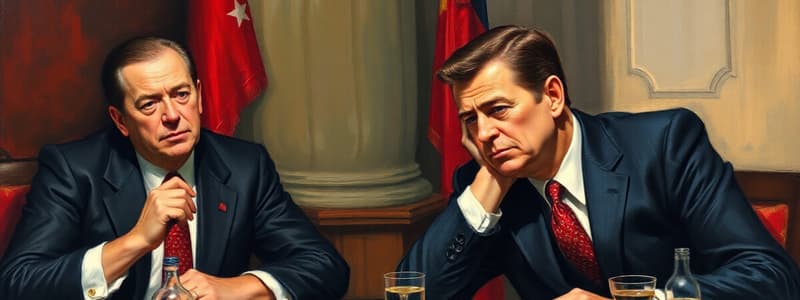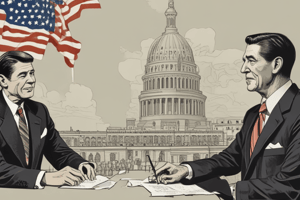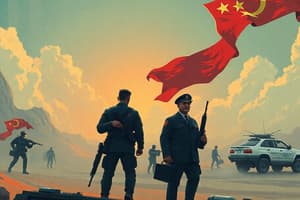Podcast
Questions and Answers
What fundamental ideological difference fueled the Cold War tensions between the US and the Soviet Union?
What fundamental ideological difference fueled the Cold War tensions between the US and the Soviet Union?
- US advocating for monarchism while the Soviet Union pushed for republicanism.
- US democracy clashing with Soviet communism. (correct)
- US promoting isolationism against Soviet global expansion.
- US favoring agrarian economy versus Soviet industrial economy.
The primary reason the Cold War never escalated into a full-scale war was the mutual agreement between the US and the Soviet Union to limit military spending.
The primary reason the Cold War never escalated into a full-scale war was the mutual agreement between the US and the Soviet Union to limit military spending.
False (B)
Explain the concept of 'containment' as it relates to the US foreign policy during the Cold War.
Explain the concept of 'containment' as it relates to the US foreign policy during the Cold War.
Containment refers to the US policy of preventing the spread of communism around the world.
The division of Germany after World War II resulted in _______ Germany, controlled by the Americans, British, and French, and _______ Germany, controlled by the Soviet Union.
The division of Germany after World War II resulted in _______ Germany, controlled by the Americans, British, and French, and _______ Germany, controlled by the Soviet Union.
Match the following events, people and terms with their significance:
Match the following events, people and terms with their significance:
What was the significance of President Reagan's 1987 speech at the Berlin Wall?
What was the significance of President Reagan's 1987 speech at the Berlin Wall?
The fall of the Berlin Wall in 1989 immediately led to the end of the Cold War.
The fall of the Berlin Wall in 1989 immediately led to the end of the Cold War.
What event officially marked the end of the Cold War?
What event officially marked the end of the Cold War?
After President Reagan left office, __________ won the 1988 elections and took office on January 20, 1989.
After President Reagan left office, __________ won the 1988 elections and took office on January 20, 1989.
Match the following branches of the U.S. government with their primary function:
Match the following branches of the U.S. government with their primary function:
Which president broke the tradition set by George Washington by serving more than two terms?
Which president broke the tradition set by George Washington by serving more than two terms?
The 22nd Amendment, which limited presidents to serving two terms, was in place since the beginning of the United States.
The 22nd Amendment, which limited presidents to serving two terms, was in place since the beginning of the United States.
Briefly describe the 'checks and balances' system within the U.S. government and explain its importance.
Briefly describe the 'checks and balances' system within the U.S. government and explain its importance.
If the President ________ a law passed by Congress, Congress can still override the President's veto.
If the President ________ a law passed by Congress, Congress can still override the President's veto.
What role does the Supreme Court play in the system of checks and balances?
What role does the Supreme Court play in the system of checks and balances?
Flashcards
What was the Cold War?
What was the Cold War?
A period of geopolitical tension between the US and the Soviet Union and their respective allies, without direct military conflict.
What is containment?
What is containment?
The policy of preventing the spread of communism.
What was the Berlin Wall?
What was the Berlin Wall?
A concrete barrier that divided Berlin from 1961 to 1989.
What was West Germany?
What was West Germany?
Signup and view all the flashcards
What was East Germany?
What was East Germany?
Signup and view all the flashcards
Who was Mikhail Gorbachev?
Who was Mikhail Gorbachev?
Signup and view all the flashcards
When did the Berlin Wall fall?
When did the Berlin Wall fall?
Signup and view all the flashcards
When did the Soviet Union dissolve?
When did the Soviet Union dissolve?
Signup and view all the flashcards
Separation of powers
Separation of powers
Signup and view all the flashcards
What is the legislative branch?
What is the legislative branch?
Signup and view all the flashcards
What is the executive branch?
What is the executive branch?
Signup and view all the flashcards
What is the judicial branch?
What is the judicial branch?
Signup and view all the flashcards
What are checks and balances?
What are checks and balances?
Signup and view all the flashcards
What is creating bills?
What is creating bills?
Signup and view all the flashcards
What is vetoing?
What is vetoing?
Signup and view all the flashcards
Study Notes
- The 1980s marked a period of significant political events, including the easing of tensions between the US and the Soviet Union.
- President Reagan played a key role in bringing an end to the Cold War.
- President Reagan and Mikhail Gorbachev, the Soviet Union leader, engaged in peace talks, which de-escalated the tension between the two superpowers.
The Cold War
- The Cold War had been ongoing since the end of World War II.
- The US and the Soviet Union emerged as the world's strongest countries after World War II.
- The democratic system in the US stood in opposition to the communist system of the Soviet Union.
- The US aimed to control the spread of communism globally through the policy of containment.
- Containment is defined as the action of keeping something harmful under control or within limits.
- The term "Cold War" is used because the two nations never engaged in direct warfare.
- The Cold War was a major factor in shaping the 20th century.
- The Cold War appeared to be nearing its end by the close of the 1980s.
The Berlin Wall
- The Berlin Wall was one of the most visible symbols of the Cold War.
- In 1945, after Germany was defeated in World War II, it was divided into two parts.
- West Germany, also known as the Federal Republic of Germany after 1949, was controlled by the Americans, British, and French.
- East Germany, referred to as the German Democratic Republic since October 1949, was under Soviet Union control.
- Berlin, Germany’s capital, was also split, with West and East Germany each controlling a section, despite all of Berlin being within East Germany.
- East Germany aimed to prevent its residents from crossing into democratic West Germany.
- A belief held that democracy would negatively influence the East German population.
- The border between the two Germanys was closed in 1952, restricting East Germans from leaving without government permission.
- In August 1961, the East German government erected the Berlin Wall to stop its citizens from seeking freedom in the West.
- The Berlin Wall symbolized the division between communist and democratic nations in Europe.
- Families were separated and unable to reunite when the Berlin Wall was erected.
- Some East Germans were killed while attempting to escape into West Germany.
- In 1987, President Reagan, standing at the Berlin Wall, urged the Soviets to tear it down as proof of their commitment to freedom and peace.
- His message increased calls for the removal of the wall.
- The Berlin Wall fell in 1989.
- The fall of the wall symbolized the end of the divide between the US and Eastern Europe, although the Cold War had not ended.
- The Cold War was coming to an end.
- The Soviet Union officially dissolved in December 1991 after Soviet countries fought to leave, marking the end of the Cold War.
- President Reagan concluded his two terms in office.
- George H. W. Bush, Reagan's vice president, secured victory in the 1988 elections and assumed office on January 20, 1989.
- There was a tradition of presidents serving only two terms until 1951, when the 22nd Amendment was introduced.
- George Washington, the first US president, initiated this tradition when he retired after two terms.
- FDR decided to serve for more than two terms because of the Great Depression and World War II.
- FDR is the only president to have served for four terms.
Three Branches of Government
- The presidency is one of the three branches of the U.S. government.
- The Constitution serves as the supreme law of the US.
- The Constitution created the three branches of government.
- The legislative branch, which creates laws, is the first branch.
- The legislative branch includes Congress, the Senate, and the House of Representatives.
- The executive branch is the second branch, and it includes the president, vice president, and the president’s cabinet.
- The president's cabinet is made up of the president's special advisers.
- The executive branch carries out, or executes, laws.
- The judicial branch includes the Supreme Court and other federal courts, making it the third branch.
- The judicial branch interprets the law.
- The three-branch system ensures a separation of powers.
- The colonists sought a system where no single part of the government could become too powerful after the American Revolution.
- The three branches prevent the president from becoming a king, while still allowing for strong leadership.
- Through checks and balances, each branch prevents the others from having too much power.
- To ensure that one branch does not become too powerful, each branch is given distinct authorities and responsibilities.
- Each branch requires the other branches to function.
- They assure that the other branches act constitutionally through checks and balances, and according to the laws of the Constitution.
- Congress creates bills, which become laws through the legislative branch.
- The president can sign a bill to become a law, or vetoe it through the executive branch.
- Congress can override a presidential veto.
- The Supreme Court has the power to declare a law unconstitutional.
- The Constitution is made up of checks and balances.
- Despite appearing complicated, checks and balances and the separation of powers are part of what makes our government a democracy.
Studying That Suits You
Use AI to generate personalized quizzes and flashcards to suit your learning preferences.




